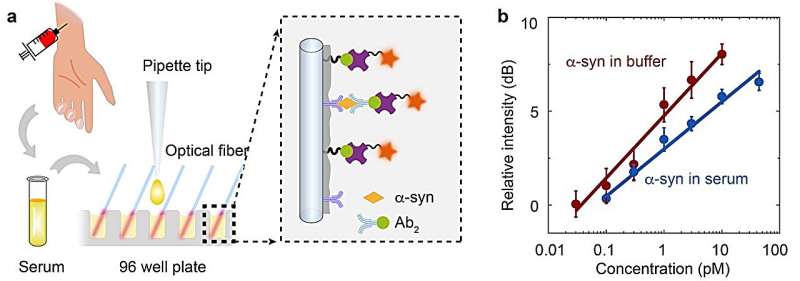This article has been reviewed according to Science X's editorial process and policies. Editors have highlighted the following attributes while ensuring the content's credibility:
fact-checked
peer-reviewed publication
proofread
Submonolayer biolasers: Lower gain, higher sensitivity

Designing sensitive and single-use biosensors for early diagnosis remains a major challenge. Scientists in China have invented submonolayer lasers on optical fibers as ultrasensitive and disposable biosensors.
A six-order-of-magnitude improvement in the lower limit of detection (LOD) when compared to saturated monolayer lasers was obtained. They demonstrated an ultrasensitive immunoassay for a Parkinson's disease biomarker, alpha-synuclein (α-syn), with a lower LOD of 0.32 pM in serum.
Early detection of diseases such as cancer and dementia, before they manifest serious, irreversible symptoms, is of considerable public health importance and can help reduce morbidity and mortality. In the early stage of a disease, precisely estimating the extremely low concentrations of biomarkers is difficult.
Optical microcavities have evolved as a powerful platform for amplifying optical signals with strong cavity feedback over the last two decades, and they have been widely used for biological analysis. The strong dependence on delicate fabrication procedures and the essential coupling requirement, however, is highly undesirable for single-use biosensors.
In a new paper published in Light: Science & Applications, a team of scientists, led by Professor Yuan Gong from Key Laboratory of Optical Fiber Sensing and Communications (Ministry of Education of China), School of Information and Communication Engineering, University of Electronic Science and Technology of China, Chengdu, China, and co-workers have developed submonolayer biolasers on optical fiber as ultrasensitive and disposable biosensors.
They realized mass production of the submonolayer biolasers at negligible cost by using optical fiber microcavities that were distributed across an extraordinary length of 10 km and had ultrahigh Q-factors of 106. In striking contrast to passive microcavities, pumping and detection of submonolayer biolasers can be conveniently performed by free-space optics, which eliminates the dependence on critical waveguide coupling, and more importantly, enabling the development of single-use biosensors with ultrahigh sensitivity.
More surprisingly, by pushing the gain molecules down to the threshold density, they demonstrated that the submonolayer biolaser shows a six-orders-of-magnitude improvement in the lower limit of detection (LOD) compared to the monolayer biolaser.
The team also demonstrated that their submonolayer biolaser can potentially be employed in clinical diagnosis. They employed the submonolayer biolaser to detect a Parkinson's disease (PD) biomarker in serum and obtained a lower LOD of 0.32 pM. This result is approximately three orders of magnitude lower than the α-syn concentration in the serum of Parkinson's disease patients. The proposed method offers great potential in high-throughput clinical diagnosis with ultimate sensitivity.

The scientists summarize the mechanism of submonolayer biolaser, saying, "We found that the submonolayer biolaser with optical gain slightly above the lasing threshold has the highest sensitivity. This phenomenon can be explained by the contribution of the gain molecules in lasing action.
"For example, when 10,000 gain molecules participate in lasing, the average contribution of each molecule is 1/10,000. Once we decrease the gain molecules to 100, the average contribution of each molecule will increase to 1/100. The binding of one analyte molecule on the optical fiber will increase one more binding site for a gain molecule. Therefore, a higher sensitivity can be expected with [a] biolaser with fewer gain molecules.
"We chose commercial optical fiber as [a] microcavity to demonstrate this hypothesis. The geometry and surface properties of optical fiber were well controlled during the fiber drawing process. The optical fiber can be regarded as distributed microcavities with highly reproducible performance.
"Meanwhile, the price of optical fiber is very low, making disposable sensors possible. For example, the price of SMF-28e optical fiber used in our experiment is about $0.5 per meter. The submonolayer laser is fabricated with a fiber segment about 2 cm long, corresponding to a neglectable cost of about $0.01.
"The submonolayer biolaser is a general sensing platform, which can be employed to detect types of biomarkers. The single-use laser-based biosensors with ultrahigh sensitivity could enable cost-effective and early diagnosis of major diseases."
More information: Chaoyang Gong et al, Submonolayer biolasers for ultrasensitive biomarker detection, Light: Science & Applications (2023). DOI: 10.1038/s41377-023-01335-8
Journal information: Light: Science & Applications
Provided by TranSpread





















